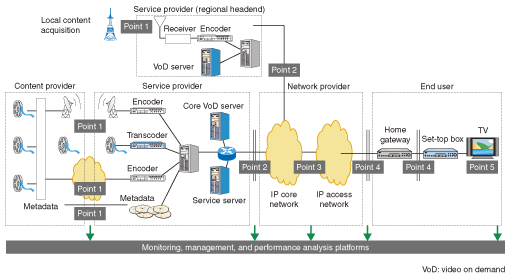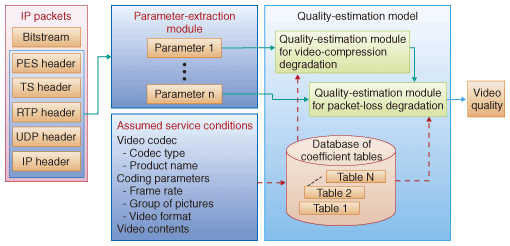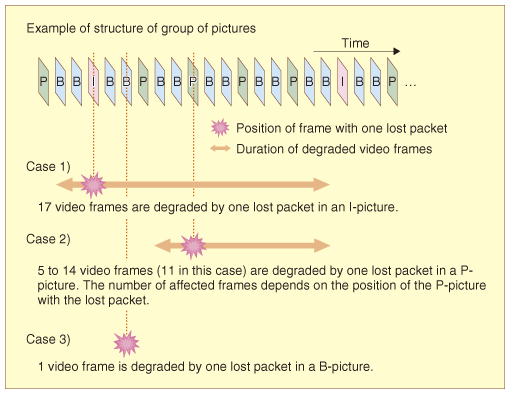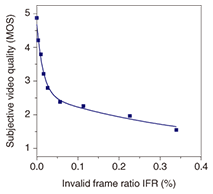 |
|||||||||||||||||
|
|
|||||||||||||||||
|
Special Feature: Quality of Experience (QoE) Design and Management for Audiovisual Communication Services Vol. 7, No. 4, pp. 37–41, Apr. 2009. https://doi.org/10.53829/ntr200904sf6 Packet-layer Model for End-user QoE ManagementAbstractThis article introduces a packet-layer model that estimates users°« quality of experience (QoE) of audiovisual communication services from packet header information. This model can be incorporated into a client terminal (e.g., home gateway and set-top box) because the computational load for quality estimation is very light. Therefore, this model is applicable to in-service quality management at user premises.
1. QoE managementTo provide a high quality of experience (QoE) of audiovisual communication services (e.g., IPTV (Internet protocol television) and videophone services), it is important to manage the QoE of each user during service use as well as to design applications, networks, and client terminals before a service is offered [1]–[3]. Although conventional methods [4] manage the network quality of service (QoS) by monitoring the network performance (e.g., packet-loss ratio and delay), they do not assess QoE by taking into account factors outside the network, such as the type of encoder and client terminal. Therefore, it would be desirable to develop an objective quality assessment model that can estimate a user°«s actual QoE while using a service. This article describes a packet-layer model that estimates the video quality of IPTV services from information in packet headers. 2. Framework of QoE management for IPTV servicesITU-T (International Telecommunication Union, Telecommunication Standardization Sector) Recommendation G.1081 defines performance monitoring points for IPTV services that will enable the service provider and/or network operator to monitor the performance of the whole IPTV service, as shown in Fig. 1.There are five performance monitoring points: the source media and metadata are monitored to confirm an appropriate quality at point 1, encoded and packetized source media are monitored at point 2, packet transmission characteristics are monitored at point 3, the received packets are monitored to check that they can adequately provide the required QoE at the client terminal at point 4, and the displayed media are monitored at the client terminal at point 5.
ITU-T Recommendation G.1081 does not define how objective quality assessment models should be applied to each performance monitoring point. Managing the QoE at the headend is important because quality degradation at points 1 and 2 influences the QoE of all users. In these cases, full reference (FR) media-layer models are suitable; these are introduced in other articles in this Special Feature [5], [6]. It is desirable to analyze packets using a method with a low computational load at points 3 and 4 because such a function needs to be implemented in terminals such as home gateways and set-top boxes. In these cases, packet-layer models [6], [7] and bitstream-layer models [6] are suitable for estimating QoE from IP packet information. Packet-layer models can be used even if the payloads of transmitted packet are encrypted because they read the packet headers rather than the payloads. At point 5, it is essential to monitor the QoE by using the no-reference (NR) media-layer model, which estimates QoE by using received media signals at the client terminal. If all the information gathered at these monitoring points is integrated, the locations of quality degradation can be determined. This article describes a packet-layer model that is applicable to points 3 and 4. 3. Framework of packet-layer modelPacket-layer models are suitable for in-service quality management at the network mid-point (point 3) and terminals (point 4) because they can estimate the QoE by using transmitted packet headers (e.g., IP, user datagram protocol (UDP), realtime transport protocol (RTP), transport stream (TS), and packetized elementary stream (PES) headers). These models need to assume some parameters (e.g., codec type, coding parameters, client, and content) as well as a planning model [1]. However, packet-layer models cannot take into account content-dependent video quality because, by definition, transmitted packet payloads cannot be read. Therefore, typical or seriously degraded video contents are assumed, and quality estimation and management are conducted based on these assumed video contents. Because video quality depends on codec implementation (e.g., the rate-distortion algorithm), it is impossible to develop a universal model for various codecs. However, the qualitative tendency of video quality degradation does not depend on codec implementation [1], so the form (e.g., logistic and exponential functions) of the packet-layer model can be unified and the model’s coefficients are optimized for an assumed service condition (e.g., codec type (H.264 or MPEG-2), coding parameters (frame rate and video format), client (set-top box or mobile phone), and video contents). ITU-T Study Group 12 (SG12) started investigating a packet-layer model for IPTV services. This project is provisionally called P.NAMS (non-intrusive parametric model for the assessment of performance of multimedia streaming) and is expected to be standardized in 2010. The model’s framework consists of three modules and a database, as shown in Fig. 2. The parameter-extraction module extracts parameters (e.g., coding bit rate and packet-loss information) from transmitted packet headers. The quality-estimation module for video-compression degradation takes the coding bit rate as input and estimates the video quality affected by only video compression. The quality-estimation module for packet-loss degradation takes packet-loss information and video quality affected by video compression as inputs and estimates the video quality affected by video compression and packet-loss degradations. The database of coefficient tables stores coefficients that are optimized for an assumed service condition (e.g., video codec type, coding parameters, and video content) and inputs them to the quality-estimation modules.
4. Quality estimation modulesInformation about the boundary of a frame and/or slice in a packet stream is often indicated by the marker bit in the RTP header or the payload-unit-start-indicator in the TS header (ITU-T Rec. H.222). In such cases, the frame type (e.g., intra-coded (I), predictive-coded (P), or bidirectionally predictive-coded (B) pictures) can be estimated based on the number of packets per frame. Since a model utilizing frame type information is expected to improve quality-estimation accuracy for packet-loss degradation, NTT developed a frame-type estimation technique. A model that estimates video quality based on packet-loss events [7] is described elsewhere in this Special Feature [1], so this article focuses on a model that estimates video quality degraded by packet loss based on frame type. There are some cases in which one lost packet leads to serious quality degradation in multiple video frames. The duration of the degradation depends on the type of video frame (i.e., I or P frame) that lost the packet and on the structure of a group of pictures, as shown in Fig. 3. Therefore, we define a new quality estimation factor, the invalid frame ratio. It is calculated as the number of degraded frames divided by the total number of frames. Video-quality characteristics, which quality-estimation modules take into account, are shown in Fig. 4. The figure suggests that subjective video quality decreases with increasing invalid frame ratio.
The quality estimation module for video-compression degradation is explained in detail elsewhere [1], [7]. The quality estimation module for packet-loss degradation uses the invalid frame ratio and video quality, which is estimated by the quality estimation module for video-compression degradation, as inputs and estimates the video quality affected by video compression and packet loss. 5. Quality estimation accuracyWe conducted subjective quality assessments to validate quality estimation by our model. Video content was coded by an H.264 codec in high-definition format. The experimental parameters were coding bit rate and packet-loss ratio. The relationship between subjective video quality and estimated video quality is shown in Fig. 5, which also shows the Pearson-correlation coefficient (R). We can see from Fig. 5 that the video quality was estimated with sufficient quality estimation accuracy. Therefore, our model is applicable to the quality estimation of video quality degraded by video compression and packet loss.
6. Application scenarioThis section explains an application scenario, in which the packet-layer model is applied to the quality management of IPTV services. Our model can estimate video quality based on the coding bit rate calculated from the received packets and on the invalid frame ratio calculated from the packets lost by the network, the packets discarded by the jitter buffer, and the packets recovered by forward error correction at monitoring points 3 and 4. Because this model should be implemented in home gateways and set-top boxes and monitors the QoE at points 3 and 4, it can detect where quality degradation occurs. 7. ConclusionIn this article, we described a packet-layer model that estimates video quality degraded by video compression and packet loss by using invalid frame ratios. After explaining the model’s framework, we described its quality estimation modules. Test results showed that this model can estimate video quality with sufficient accuracy. Therefore, we believe that it can be effectively applied to the quality management of IPTV services. References
|
|||||||||||||||||
















